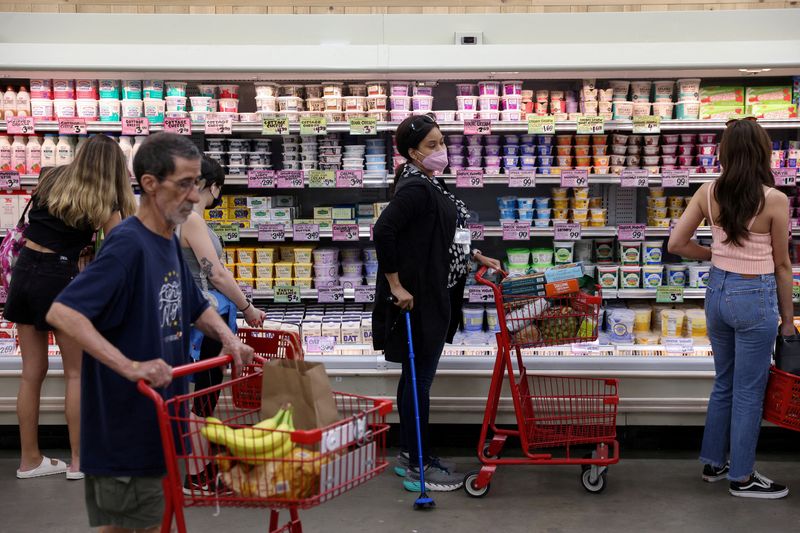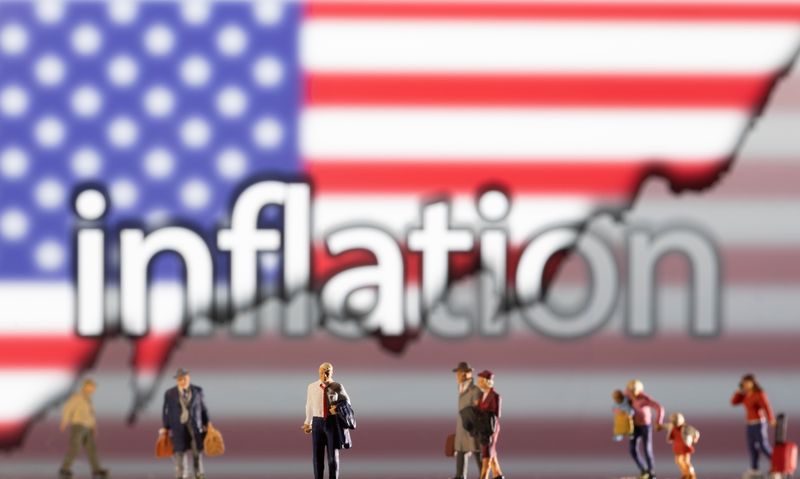By Lindsay (NYSE:LNN) Dunsmuir
(Reuters) - U.S. consumer prices were unchanged in July due to a sharp drop in the cost of gasoline, delivering the first notable sign of relief for weary Americans who have watched inflation climb over the past two years.
The Consumer Price Index (CPI) was flat last month after advancing 1.3% in June, the Labor Department said on Wednesday in a closely watched report that nevertheless showed underlying inflation pressures remain elevated as the Federal Reserve mulls whether to embrace another super-sized interest rate hike in September.
The reading was the largest month-on-month deceleration of price increases since 1973 and followed on the heels of a roughly 20% drop in the cost of gasoline since mid-June. Prices at the pump spiked in the first half of this year due to the war in Ukraine, hitting a record-high average of more than $5 per gallon on June 14, according to motorist advocacy group AAA.
GRAPHIC: Dramatic drop in U.S. inflation (https://graphics.reuters.com/USA-ECONOMY/INFLATION/lgpdwyowzvo/chart_eikon.jpg)
Economists polled by Reuters had forecast a 0.2% rise in the monthly CPI in July. The Fed has indicated that several monthly declines in CPI growth would be needed before it lets up on the aggressive monetary policy tightening it has delivered to tame inflation currently running at a four-decade high and bring it down to its 2% goal.
But the lower-than-expected CPI data ignited a strong rally in equity markets, with the S&P 500 index up about 2% in early afternoon trading. Investors immediately pared bets the Fed would deliver a third straight 75-basis-point rate hike at its Sept. 20-21 meeting, instead seeing the U.S. central bank likely to opt for a half-percentage-point hike.
"This is not yet the meaningful decline in inflation the Fed is looking for. But its a start and we expect to see broader signs of easing price pressures over the next few months," said Paul Ashworth, chief U.S. economist at Capital Economics.
GRAPHIC: Inflation set to ease, but by how much? (https://graphics.reuters.com/USA-ECONOMY/INFLATION/gkvlgodjjpb/chart.png)
U.S. consumer prices have been surging due to a number of factors, including snarled global supply chains, massive government stimulus early in the COVID-19 pandemic and Russia's invasion of Ukraine.
Food is one component of the CPI that remained elevated in July, rising 1.1% after climbing 1.0% in June.
The price of gasoline fell 7.7% in July.
GRAPHIC: U.S. pump prices drop from record high (https://graphics.reuters.com/USA-ECONOMY/GASOLINE-INFLATION/znvnerklmpl/chart.png)
In the 12 months through July, the CPI increased by a weaker-than-expected 8.5% following a 9.1% rise in June. Underlying inflation pressures, which exclude volatile food and energy components, also showed some green shoots despite remaining strong.
The so-called core CPI rose 0.3% in July, a 10-month low, after climbing 0.7% in June, helped by an almost 8% fall in the cost of airline fares, but still increased 5.9% in the 12 months through July, matching the pace in June.
Inflation in the cost of rent and owners' equivalent rent of primary residence, which is what a homeowner would receive from renting a home, rose at almost the same pace as in June. Shelter costs comprise about 40% of the core CPI measure.
GRAPHIC: Inflation (https://graphics.reuters.com/USA-STOCKS/znpnerxdlvl/inflation.png)
TIGHT LABOR MARKET
An alternate measure of consumer prices compiled by the Cleveland Fed was less encouraging. The Median CPI, which is considered a good view of the breadth of price pressures in the economy, rose 6.3% on an annual basis in July, compared to 6% in June, the regional Fed bank reported separately on Wednesday.
GRAPHIC: U.S. Inflation: A conflicting view? (https://graphics.reuters.com/USA-ECONOMY/INFLATION/lgvdwyokzpo/chart.png)
Inflation pressures until recently had been concentrated in goods, but consumers have refocused spending on services as the pandemic eased. Fed policymakers are fearful that accelerating service-sector inflation will be more difficult to unravel.
There was little relief on that front, with prices for services excluding energy-related items rising at a 5.5% annual rate in July, the same pace as in the prior month, although there was a decline in the monthly reading.
"While the July CPI report is encouraging, inflation pressures remain strong especially in the core services sector, with still buoyant increases in residential rent prices," said Kathy Bostjancic, chief U.S. economist at Oxford Economics.
GRAPHIC: As goods inflation eases, services step in (https://graphics.reuters.com/USA-FED/INFLATION/lbvgndazapq/chart.png)
An extremely tight labor market is driving up wages, which in turn contribute to higher prices for services. A separate Labor Department report on Wednesday showed real average weekly earnings rose 0.5% in July, the first monthly increase since last September and largest gain since January 2021.
The economy created an unexpectedly robust 528,000 jobs last month, the unemployment rate fell back to its pre-pandemic low, and wage gains surprised to the upside, the Labor Department announced last Friday in a monthly employment report that makes it harder for the Fed to bring the economy into balance soon.
Labor market tightness is also underscored by the fact that, although U.S. job openings fell to a nine-month low in June, there were still almost two jobs for every unemployed person.
The Fed has hiked its policy rate by 225 basis points since March despite fears that the sharp rise in borrowing costs could tip the economy into recession.
The U.S. economy unexpectedly contracted in the second quarter, with consumer spending growing at its slowest pace in two years and business spending declining.

The second straight quarterly decline in gross domestic product largely reflected a more moderate pace of inventory accumulation by businesses.
That trend was highlighted by a Commerce Department report on Wednesday showing U.S. wholesale inventories increased 1.8% in June, instead of 1.9% as reported last month.
